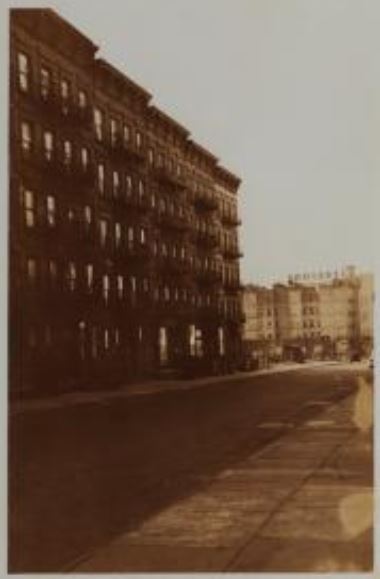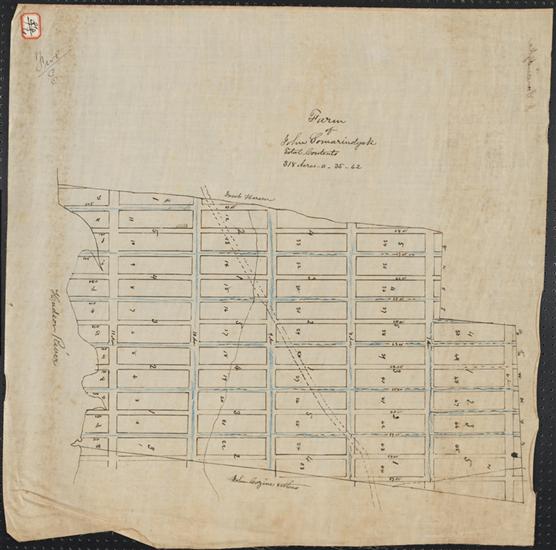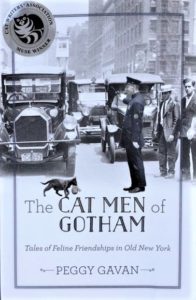Cats in the Mews: May 30, 1897

On May 30, 1897, The New York Times and New York Sun reported the following tale of a cat fight that took place in the Battle Row neighborhood on the west side of Manhattan:
The previous night, Patrick W. Gallagher, who lived on the second floor of a brick tenement building at 237 West 60th Street, took his week’s pay home to his wife. Then he went out for whatever reason you choose to imagine. Mrs. Gallagher decided to use some of that money to buy ice cream, so she also left the apartment. The married couple’s actions paved the way for a disastrous cat fight.

According to The New York Times, a 10-year-old girl named Maggie Callahan was left alone in the apartment with the Gallagher’s two black cats. (The New York Sun tells a slightly different tale; it reports that the family had only 1 brindle cat, and the second cat showed up uninvited via a fire escape).
Maggie took the two cats into the parlor in the front of the apartment and watched as they began to play. She was distracted by children playing outside across the street, so she went to an open window to watch them.
The cats began chasing each other around a table in the center of the room, on which stood a kerosene lamp. One cat jumped up on the table, and you can guess what happened.
The lamp exploded, and the flames began spreading (the Sun says one of the cats caught fire and ran around the room before jumping out a window; the Times says one of the cats was burned, but its injuries were minor).

Anne Keane, Mrs. Gallagher’s mother, heard the cat fight and the explosion from her apartment just above the Gallaghers. She went to investigate, and, finding the door locked, she grabbed a flatiron from who knows where and smashed the lock off the door.
John O’Neil, who lived across the street, saw Maggie at the open window. She was reportedly about the jump out, so he ran up the stairs, into the smoke-filled room, and grabbed the young girl.

As the smoke began filling the hallway, other people among the 16 families who lived in the building began trying to get out. Six men ran outside and turned in a fire alarm. Other men ran through the building to help the women and children get outside.
According to the Sun, Mrs. Johnson and Mrs. McIlvaney, who lived in the back rooms behind the Gallaghers, tried to make it down the stairs at the same time. Both women were “stout and short of breath,” and they ended up getting wedged together on the first-floor landing.
The two women began fighting and pushing at each other, both refusing–or unable–to budge. Finally, the firemen arrived and, “after some difficulty,” they were able to some kind of wedge tool to separate the women.
I have no idea if any firemen were able to get past the women in order to get to the fire, or if the fire continued to burn until the human “blockage” was removed. Either way, as I like to say, you can’t make this stuff up.
The fire caused about $100 worth of damage. Mrs. Gallagher arrived back home with her ice cream just in time to see the firemen getting ready to leave.
One of the cats apparently disappeared; the other cat remained in the room with his back arched and his tail puffed up, apparently ready to get into another fight with the next intruder.
As the Times reported, “The only other damage was to the tempers of Mrs. Johnson and Mrs. McIlvaney.”
West 60th Street and West End Avenue

This cat fight story takes place in what was once a crime-ridden neighborhood called Battle Row, near the old 60th Street Freight Yards and Union Stock Yards. Battle Row had an evil reputation and was a source of great trouble to the police.
Street gangs and young urchins terrorized the neighborhood, and there were numerous fights, assaults, arson fires, and arrests. Living conditions were horrendous, as Jacob A. Riis documented in his photographs of these neighborhoods (there was more than one neighborhood called Battle Row in New York at this time, including one near East 60th Street and First Avenue).
The Battle Row neighborhood on the west side occupied the site of a former 10-acre farm and picnic grounds owned by John and Adelaide Low in the early 1800s. This land was once part of a much larger, 318-acre farm owned by Johannes and Catharine Van Brugh, who had received a patent from Dutch Colonial Governor Richard Nicolls on October 3, 1667 (this is the first record of colonial-era ownership).
Over the years, the land passed through many owners, including Tunis-Cornelissen and Anneke Stille, Stephen DeLancy (a British Loyalist who called the farm Little Bloomingdale), and then John Somarindyck, who purchased the land from Isaac Stoutenburgh and Philip Van Courtlandt, Commissioners of Forfeiture, for $2,500 in 1785.

John Somarindyck erected a house on Tenth Avenue between 61st and 62nd Street (about 2 blocks from where this cat fight took place). A winding road lead from the house in a southwesterly direction until it met the Bloomingdale Road (Broadway) at present-day 60th Street. In later years, Stephen DeLancy occupied this house, which was near the small hamlet he established (Little Bloomingdale or Bloomingdale Square).

In 1940, the New York City Housing Authority called the area “the worst slum section in the City of New York” and made plans to demolish all the old tenements. The Amsterdam Housing Projects were built in 1948, replacing three blocks that had collectively housed 1,100 residents. During the 1950s and 1960s, thousands of more tenement residents were displaced as part of the Lincoln Square Renewal Project.
Incidentally, the scenes in the opening 20 minutes of West Side Story were filmed just a few blocks north of this site, among the about-to-be-demolished tenements on West 68th Street between Amsterdam Avenue and West End Avenue. These tenements were also razed as part of the Lincoln Square Renewal Project.





Thank you for yet another interesting post. Love these!
I’m glad you enjoy the stories! I really love doing the research and finding these amazing cat tales to share. Hopefully you can attend one of my virtual presentations — I’ll be posting today about my June presentation.